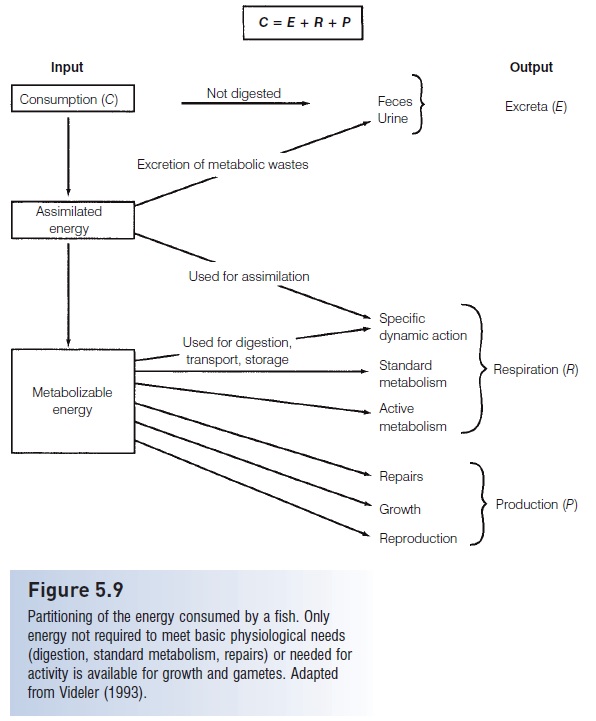Chapter: The Diversity of Fishes: Biology, Evolution, and Ecology: Oxygen, metabolism, and energetics
Bioenergetics models of Fishes
Bioenergetics models
Bioenergetics models can aid in understanding energyintake and utilization. The construction of a bioenergetics model is a complex process because the energetic costs and benefits of all physiological activities must be accounted for if the model is to provide a reasonably realistic view of how energy is being allocated. In addition, each individual organism is different. Consequently, bioenergetics models, like any physiological model, provide a broad conceptual framework, rather than a precise prediction of what will happen in any particular organism. Bioenergetics models can, however, be useful in understanding how energy is allocated, and may be used to estimate the impacts of environmental alterations on rare species (Petersen & Paukert 2005). In addition, bioenergetics models of individual species can be used to construct community bioenergetics models, thereby providing some understanding of energy flow through ecosystems and estimating how fish populations may be impacted by factors such as predators, invasive species, and climate change (see Bajer et al. 2003). But such models should be used cautiously – Bajer et al. (2003) applied two bioenergetic models to a controlled study of

Figure 5.9
Partitioning of the energy consumed by a fish. Only energy not required to meet basic physiological needs (digestion, standard metabolism, and repairs) or needed for activity is available for growth and gametes. Adapted from Videler (1993).
Several methods can be used to determine the energetic content of food items, waste products, or components offish growth such as tissue or gametes (see Wootton 1998).The energetic costs of different activities can be estimated either by direct calorimetry (measuring the heat produced by an organism) or some form of indirect calorimetry, such as measuring oxygen consumption. We can then construct a conceptual model (Fig. 5.9) to represent how energy may be partitioned.
The energy equation is often represented as:
C =E +R +P,
where C is the energy consumed,
E is the energy excreted,
R is the energy used in respiration, and
P is the energy remaining for production.
Some of the potential energy in food will never be digested and is therefore lost in the feces. The proportion that is digested is sometimes represented by the absorption efficiency(or “digestibility”) and varies for different food types. Carnivorous fishes feeding on soft-bodied, highly digestible prey may have absorption efficiencies as high as 90% or more, whereas herbivores tend to have considerably lower absorption efficiencies (e.g., 40–65%; see Wootton 1998). In general, foods high in lipids and proteins have much higher absorption efficiencies than foods high in carbohydrates.
Of the energy that is absorbed during digestion, some is subsequently lost through the excretion of nitrogenouswastes. An additional 10–20%, depending on the amount and type of food consumed, is used in providing the energy needed for digestion (Jobling 1981). Larger meals and foods with higher protein content require more energy to digest and assimilate.
The remaining absorbed energy must be allocated among maintaining metabolism, swimming or other forms of activity, and the production of gametes or new somatic tissue (growth). Only energy remaining after other physiological maintenance needs have been met is available for growth or reproduction. Therefore, any factors that increase other metabolic demands can ultimately decrease growth or reproduction. Environmental factors affect the amount of energy needed to sustain metabolism. Increased temperature often elevates metabolism and increases the need for energy. Other energetic costs include the maintenance of proper salt and water balance (osmo regulation) and the costs of health maintenance by the immune system. Energy requirements for basic maintenance may increase due to changes in salinity, or energy diverted to fighting infections, diseases, or parasites. In addition, exposure to contaminants that affect ion or water balance or that diminish the effectiveness of a fish’s immune system can indirectly divert more energy away from growth and reproduction.
Related Topics